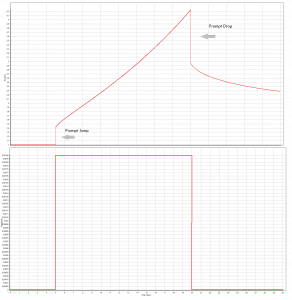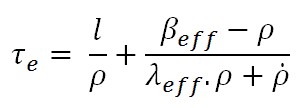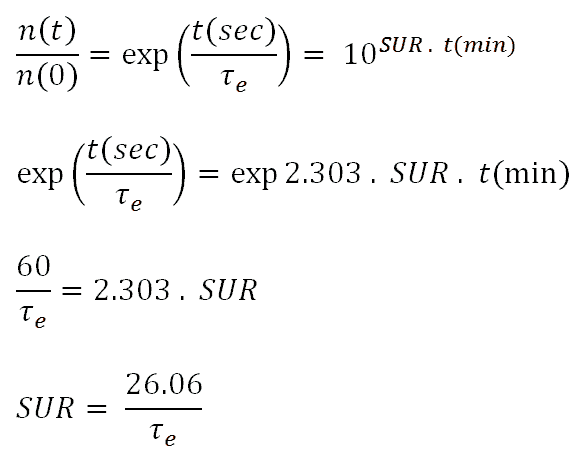Reactor Period
Reactivity is not directly measurable, and therefore most power reactors procedures do not refer to it, and most technical specifications do not limit it. Instead, they specify a limiting rate of neutron power rise (measured by excore detectors), commonly called a reactor period (especially in the case of BWRs).
The reactor period, τe, or e-folding time, is defined as the time required for the neutron density to change by a factor e = 2.718. The reactor period is usually expressed in units of seconds or minutes.
At this time:
where:
n(t) = transient reactor power
n(0) = initial reactor power
τe = reactor period
The smaller the value of τe, the more rapid the change in reactor power. The reactor period may be positive or negative. If the reactor period is positive, reactor power increases. If the reactor period is negative, reactor power decreases. If the reactor period is constant with time, as associated with exponential power change, the rate is a stable reactor period. If the reactor period is not constant but is changing with time, for non-exponential power change, the period is referred to as a transient reactor period.
Derivation of the formula τe = ld / (k-1) is based on many assumptions, and it is the simplest approximation of the reactor period. A much more exact formula reactor period is based on solutions of six-group point kinetics equations. An equation called the inhour equation (which comes from an inverse hour, used as a unit of reactivity that corresponded to e-fold neutron density change during one hour) might be derived.
where:
l = prompt neutron lifetime
βeff = effective delayed neutron fraction
λeff = effective delayed neutron precursor decay constant
τe = reactor period
ρ = reactivity

The first term in this formula is the prompt term, and it causes that the
positive reactivity insertion is followed immediately by an immediate power increase called the prompt jump. This power increase occurs because the production rate of prompt neutrons
changes immediately as the reactivity is inserted. After the prompt jump, the power change rate cannot increase any more rapidly than the built-in time delay the precursor half-lives allow. Therefore the second term in this formula is called the delayed term. The presence of delayed neutrons causes the power rise to be controllable, and the reactor can be controlled by control rods or another reactivity control mechanism.
The following equations give the relationship between reactor period and startup rate:
Example:
Suppose keff = 1.0005 in a reactor with a generation time ld = 0.01s. Calculate the reactor period – τe, doubling time – DT, and the startup rate (SUR) for this state.
ρ = 1.0005 – 1 / 1.0005 = 50 pcm
τe = ld / k-1 = 0.1 / 0.0005 = 200 s
DT = τe . ln2 = 139 s
SUR = 26.06 / 200 = 0.13 dpm


